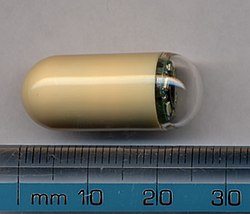Enteroscopy
Enteroscopy is a procedure for direct visualization of the small bowel. There are two major types of enteroscopy.
Capsule enteroscopy[edit | edit source]
Capsule enteroscopy is a diagnostic method that visualizes the mucosa, stenosis, tumors or polyps of small bowel. After a patient swallows the capsule, it passes along the gastrointestinal tract taking a number of images per second which are transmitted wirelessly to an array of receivers connected to a portable recording device carried by the patient.
Procedure[edit | edit source]
A day prior to the procedure, pacient should eat only light meals and drink large amount of fluids, or 2 liters of isoosmolar solution (Fortrans)- similar to, for example, before colonoscopy . On the day of the examination, patient swallows the capsule (26x11 mm), which then passes naturally through the intestine. The capsule is able to photograph the lumen of the intestine, at a speed of 2 frames per second (in case of esophageal examination 8 frames per second). The patient has electrodes attached to his abdomen, which sense the course of the capsule, and allows for saving the captured photographs. A computer then creates a video of the photos taken. The whole procedure lasts approximately 10 hours. The patient can drink after 2 hours and eat after 4 hours. The capsule comes out naturally in 1 to 5 days.
Indications[edit | edit source]
- unknown source of hemorrhage in the gastrointestinal tract
- Crohn's disease
- Polyposis
- Small bowel tumors
- Celiac disease – The enteroscopy is used to dispense celiac disease non responding to diet, which are considered precancerosis of T- lymphoma
- Malabsorption
Contraindications[edit | edit source]
- when obstruction or stenosis is suspected (in active Crohn's disease)
- children (< 10 years)
Complications[edit | edit source]
- retention of the capsule (for longer than 14 days); if necessary, can be removed surgically
Balloon enteroscopy[edit | edit source]
Single-balloon or double-balloon enteroscopy is a procedure that visualises the small bowel. It allows for therapeutical interventions.
Procedure[edit | edit source]
The procedure is done under general anaesthesia, because it takes long time and can be painful. An endoscope and one or two balloons are used. The balloons are inflated and fixed in a part of the intestine, then the endoscope is inserted further and continued. The intestine "wrinkles" on the endoscope. The examination proceeds gradually in both directions, through the mouth, stomach and then through the large intestine.
Indications[edit | edit source]
- Polypectomy
- Biopsy
Complications[edit | edit source]
- hemorrhage
- perforation
- acute pancreatitis (mechanical irritation z mechanického dráždění hlavy pankreatu)



